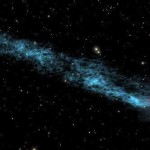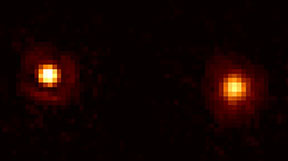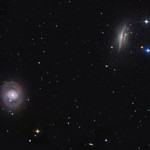Call me Ishmael (my name is actually Paul). Whenever a balmy November wind blows across my bow and chills me to the bone, when the brisk November air suggests that autumn is turning to winter, when the skies of night become calm and tranquil and abound with good astronomical seeing, and whenever I find my heart longing for a dark observing site, I account it is high time to set sail into the infinite seas of the cosmos.
Pseudo Melville, The Great Whale

NASA Image
An AFSIG Article by: Paul Trittenbach
Moby Dick is probably the most infamous manuscript of Herman Melville. Scholars may disagree that it was his best work, but the novel does touch the soul of any reader. Moby Dick is fraught with emotional and philosophical undercurrents that leaves an indelible mark upon those who voyage through it pages. Melville inspired me when I found my thoughts turning to create a web article for November. Both Moby Dick and my composition have something in common—a great whale!
The Constellation Cetus, the whale, swims in the 13.8 billion light year ocean of our universe among other constellations associated with water: Eridanus, Aquarius and Pisces. In Greek mythology Cetus was known as “the sea monster” from the myth of the princess Andromeda. According to the myth, Andromeda’s boastful mother, Cassiopeia, angered Poseidon (the god of the sea) and the Nereids (nymphs of the sea), by claiming that she was more beautiful than they. Poseidon sent Cetus to punish King Cepheus and his wife Cassiopeia for the boast, requiring that they sacrifice their daughter to the sea monster or have it ravage their land.
King Cepheus and his wife chained their daughter to a rock so the sea monster could devour her. But just as the sea monster was about the partake of this delicacy, our hero Perseus entered the picture and killed Cetus, rescuing Andromeda from her fate. Later the two were married.
Cetus sits high in the southern sky and is prime for hunting by mid month. It possesses two red giants, one a pulsating variable—which is also a binary system— an orange giant and one G-type star smaller than our sun. It has 14 stars with planets and covers 1231 square degrees of space. There are three meteor showers associated with Cetus: the Omicron Cetids, October Cetids and Eta Cetids. The constellation is also home to nine galaxies available to amateur astronomers.
Unlike Capt. Ahab, I am unwilling to chase this whale around any maelstroms or round Perdition’s flames. I just sit patiently and wait until the earth transits around the sun and the overhead sky turns to the stars of autumn. Then Cetus presents itself overhead. There are plenty of other celestial objects to keep me occupied in the meantime. But when Cetus appears overhead it offers cosmic gems worth harpooning. In pursuit of our quarry, let’s first turn toward the stars of Cetus.
“…the great floodgates of the wonder-world swung open…”
Herman Melville, Moby Dick, or The Whale
Regardless of what aperture you choose you will never see Alpha Ceti V, the planet to which the genetically superior Kahn and his band of rebels was exiled by Capt. Kirk in Star Trek, the Original Series, after attempting to commandeer his ship. Made famous by the episode “Space Seed” and revisited in the motion picture Star Trek II, “The Wrath of Kahn”, Alpha Ceti (Menkar) has been deceptively hiding her planets. Of all the extrasolar planets discovered thus far none have ever been found around this star.
Designated as the alpha star, Alpha Ceti is actually the second brightest star in the constellation. Located 249 light years away, at magnitude 2.5 Menkar is a red giant with more than twice the mass and 89 times the radius of the sun. When it dies it will shed its outer layers and evolve into a planetary nebula, a fate that our sun will share in 5 billion years. Some people believe that Menkar is designated the Alpha Star because it sits close to the plane of the ecliptic and marks the path of the sun across the sky. In Arabic Menkar means nostril. The star sits at the head of Cetus.
Deneb Kaitos—Beta Ceti— is the brightest star in Cetus. It is located 96.3 light years away and shines at a magnitude of 2.04. Deneb Kaitos is an orange giant possessing 2.8 times the mass and 16.8 times radius of the sun. Deneb Kaitos has evolved from a main sequence star and is on its way toward becoming a red giant.
Plowing its way through interstellar space at 291,000 miles/sec the variable star Mira (Omicron Ceti) creates a bow shock and leaves a 13 light-year long tail of dust and gas in its wake. That light is visible only in the ultraviolet frequencies, and was detected only recently by NASA’s Galaxy Evolution Explorer telescope. Mira is a red giant star close to the end of its life. Mira has already ejected enough mass into surrounding space to create 3,000 planets the size of our home.
When it dies it will shed off its outer layers and become a planetary nebula. Mira is also a binary system. The B star (Mira B) is a white dwarf that is accreting mass from the primary. Images taken by the Chandra X-ray Observatory show that matter from the primary star is being consumed by the white dwarf. Both stars are separated by a distance of 70 astronomical units.

Hubble image
Mira is a pulsating variable star—the first of its kind to be observed—and is now part of a class of pulsating variables known as Mira variables (M Variables). All of the stars in this class, 6 – 7000 of them, are red giants that pulsate with varying periods of brightness of between 80 to 1000 days. Mira has a period of 332 days and can vary in brightness from magnitude 2.0-10. Mira is located 420 light years from Earth.
Of all the likely candidates, you would think the Star Trek writers would have chosen for a place to maroon Kahn and his band of genetic supermen, you would think it would have been Tau Ceti. Tau Ceti is a yellow dwarf star 11.9 light years distant that shines at magnitude 3.5. Is one of a few G-type stars that possesses less mass and brightness than our sun. In 1960 it was chosen by Frank Drake as one of the original Project SETI (Project Ozma ) candidates to search for intelligent life in the universe.
At millions of light years distant, galaxies are like great white whales swimming in our ocean universe. In binocular’s and small telescopes they shine as nothing more than milky clouds on the dark backdrop of space. It is difficult for us to wrap our minds around the great distances of the cosmos. Even members of our celestial neighborhood are trillions of miles away — far beyond our reach by any means of the rules of the Einsteinian universe.
Compared to the distances in our cosmic neighborhood, these great white whales are immense! But even the distances between them and the expanse of the universe itself makes them seem like amoebas in a drop of water! So here we are, Jonahs in the belly of a great white whale, staring out into the ocean with intense curiosity.
45 million light years away is Messier 77 (M 77, NGC 1068) a barred spiral galaxy at magnitude 9.6. It is one of the largest galaxies listed in the Messier catalog and the only Messier object in Cetus. It spans 170,000 light years in diameter and is the closest and brightest of the Seifert galaxies. These are galaxies that possess hot, highly ionized gases which emit intense radiation and glow very brightly. This radiation is caused by a very Active Galactic Nucleus (AGN) — a black hole — about 15 million times the mass of our sun! M77 also has very bright arms, the result of prolific star formation.

Nasa image
Located 250 million light years away is the spiral galaxy NGC 17. You will need a large aperture telescope to see this galaxy; it possesses a magnitude of 15.3. NGC 17 is believed to be a merger between two larger disk galaxies because it demonstrates prolific starburst activity and its core is still very rich in gases.
The barred spiral galaxy NGC 45 shines at approximately a magnitude of 10.4 and is located 32.6 million light years away. You will want to use a large aperture telescope to wrestle any details from this galaxy. Although it is very large, the surface details of NGC 45 are spread out and faint. This galaxy presents itself in a nearly face-on orientation to our plane of view.
At 236 million light years away the barred spiral galaxy NGC 47 shines at magnitude 13.5. Like NGC 17 and NGC 45 you will want to use a large aperture telescope to tease out any details from this galaxy. NGC 47 is a small galaxy with a very bright core.
Much closer to us, at 11.1 million light years is NGC 247, also known as Caldwell 62. NGC 247 is a small spiral galaxy— also classified as a dwarf spiral galaxy— and one of the closest to the Milky Way. It is a member of the Sculptor group of galaxies. NGC 247 possesses a bright nucleus surrounded by stars, gas and dust. The gas forms bright knots in the HII regions that are scattered throughout the galaxy’s outer arm.
Images taken by the Hubble space telescope show that NGC 247 has a large void in the HII regions, which spans nearly 1/3 of the length of the galaxy. Stars in this void are old, red and faint, and indicate that star formation has been halted in this region. It is believed the star formation in this region has not taken place in at least 1 billion years!
At 60 million light years distance the face-on spiral galaxy NGC 1042 shines at magnitude 11.0. It is typically associated with a nearby galaxy NGC 1035 and believed to be gravitationally bound to it because both demonstrate a similar red shift. NGC 1042 possesses a very bright Active Galactic Nucleus (AGN).
Located 60 million light years away, NGC 1055 is the dominant member of a group of small galaxies which are part of the NGC 77 galaxy group. Viewed from our position, NGC 1055 is an edge-on galaxy approximately 100,000 light years across. This galaxy possesses a large box-shaped halo that extends far above and below the galactic plane. In appearance, it bears some resemblance to the Sombrero Galaxy, NGC 104.
NASA images show faint structures within the galactic halo that are believed to be remnants of an interaction with a larger spiral that took place 10 billion years ago. Like NGC 77, NGC 1055 is a prolific star producer. NGC 1055 shines at magnitude 11.4 and will require a large aperture to be able to discern its structure.
NGC 1073 is a barred spiral galaxy similar to our own Milky Way that possesses a very active nucleus that glows in the HII region. It is 80,000 light years across and 55 million light years away. Hubble space telescope images show visible dark dust lanes, glowing in the HII region, young clusters of blue stars and an active nucleus which likely contains a black hole. NGC 1073 shines at a magnitude of 11.5 so you will want a large aperture to view this galaxy.
NGC 1087 is 80 million light years distant and 86,800 light years in diameter. You will want a large aperture to capture this galaxy. It shines at magnitude 12.2. It is classified as an intermediate spiral galaxy, possessing a small central bar of irregular features surrounding a disk. The overall surface brightness of the galaxy is very low.
Oh, Starbucks (Espresso, Frappuccino, iced coffee or dark roast)! Stand fast by my side. For I stand duty watch on the Forecastle and man the spyglass!
Pseudo Melville, The Great Whale
When the cold November wind blows across your bow and the nights become tranquil and accompanied by good astronomical seeing, I hope that your heart will yearn to shove off to a remote dark location and set sail into the infinite seas of the cosmos. There is a diamond mine out there, among the stars—filled with cosmic gems.

